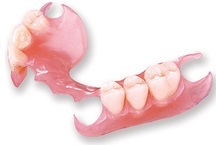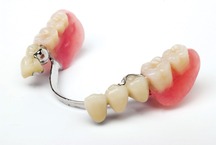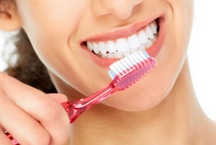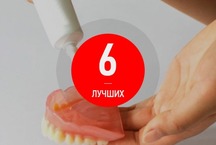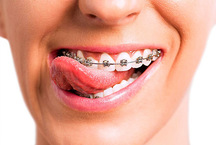Acrylic (or laminar) prostheses remain the most popular type of prosthetics with partial and complete adentia for almost a hundred years. Until the beginning of the 20th century, the basis of the removable denture was made of rubber, and later acrylic plastics were used for this. The main difference of such a prosthesis is the stiffness of the bases, through which the contours of the teeth fixed in it are not translucent.
This most accessible type of prosthetics can be used at any age, but in practice, acrylic prostheses in modern dentistry are mainly used to correct dentition defects in elderly patients. In most cases, prostheses, the basis of which is made of acrylic plastic are used for full and partial edentulous, when it is not possible to install implants or use other types of prosthetics.
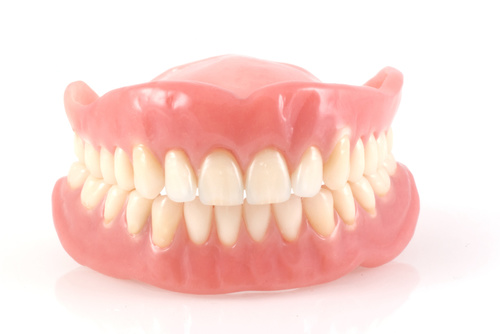
Photo: cliniqueprothesedentaire.com
Full acrylic dentures for upper and lower jaw
Advantages and disadvantages of structures made of acrylic plastic
During the planning of the elimination of the patient’s dental problems, the dentist must tell about all the advantages and disadvantages of all types of removable prosthetics so that the person can make his choice consciously.
The advantages of acrylic dentures
The main advantages of acrylic prostheses include:
- Affordable cost is the most inexpensive type of removable prosthetics.
- The ability to restore the aesthetic and functional features of the dentition in the presence of contraindications to implantation and other types of prosthetics.
- Reliability and ease of use and simple maintenance of acrylic structures.
- Uniform distribution of chewing load on the gums and abutment teeth.
- Technologically simple manufacturing of such structures.
- The ability to use this type of prosthetics in periodontal diseases (the prosthesis is made with a beam mount).
- Prosthetic manufacturing speed.
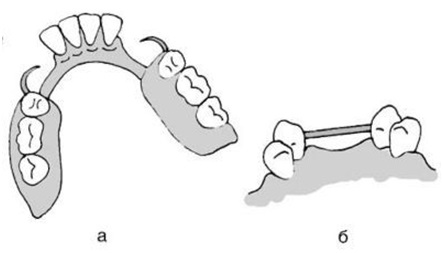
a) acrylic prosthesis
b) a beam fixed on crowns covering the abutment teeth.
The main disadvantages of acrylic dentures
Acrylic plastic orthopedic structures have the following disadvantages:
- Injury of the soft tissues of the oral cavity due to the large area of the prosthesis.
- Damage to the enamel of the abutment teeth with long-term use of dentures with clamp clamping. Abrasion of enamel can lead to the development of a carious process and tooth decay.
- The release of a toxic substance (methacrylate ester), which can cause the development of allergic reactions.
- The fragility of the base - acrylic prostheses break quite easily with increased chewing load on one point, or falling.
- In most cases, there is a weak fixation of full dentures (especially for the lower jaw) - for reliable fixation it is better to use special means (fixing paste "Korrega", for example).
- Porous structure of the base, leading to the accumulation of pathogenic microorganisms - with insufficient hygiene of the oral cavity, prolonged wearing of the prosthesis can cause the development of dental diseases of infectious and inflammatory nature (stomatitis, gingivitis, periodontitis, glossitis).
- Duration of adaptation and change of speech in the period of habituation to the prosthesis.
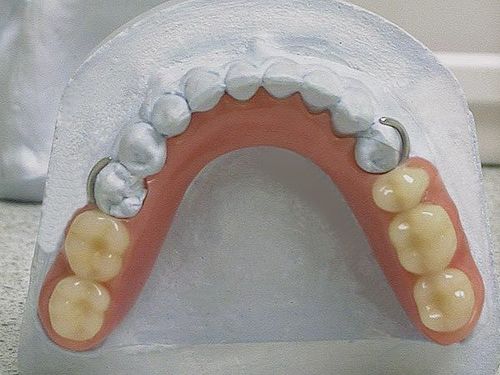
Partial denture made of acrylic plastic with clamp fixing
Despite all of its shortcomings, acrylic dentures remain the most popular prosthetic option in older people due to financial affordability.
Indications and contraindications for use
their orthopedic acrylic plastic designs
Indications
The installation of acrylic prostheses is shown in:
- partial adentia (the absence of several teeth in a row) at different ages;
- full edentulous (absence of all teeth) - you can use removable prosthetics with acrylic prostheses and based on the installed implants;
- in pediatric practice in order to prevent the development of pathological changes of bite in case of early removal of destroyed milk teeth;
- in young people as a temporary replacement of defects of the dentition in prosthetics with metal-ceramic fixed structures.
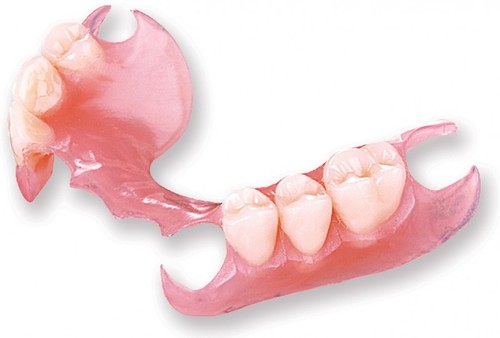
Photo: www.stomatologpushkino.ru
Temporary acrylic prosthesis
Contraindications
You can not install acrylic dentures people:
- have an allergic reaction to the material from which the base is made;
- It is not recommended to use this type of prosthetics in case of pronounced resorption of the jaw bone due to which the alveolar part becomes almost flat, in this case the prosthesis will not hold even when using fixing means;
- It is worth thinking about other types of prosthetics in the presence of a strongly pronounced gag reflex, because the use of a prosthesis in this case will be significantly difficult or not at all possible.
Features of the use of acrylic orthopedic structures
The life of the prosthesis
The average period of use of acrylic prostheses is 2-3 years after which, in most cases, they need to be replaced. With a stable dental health, proper care of the prosthesis and compliance with all operating rules, you can extend its service life to 5 years - this is the maximum duration of operation of structures made of acrylic plastic. Usually, after 2-2.5 years, the fixation of the prosthesis is broken, it begins to cause discomfort during eating or to subside when talking and laughing.
Adaptation features
It should be noted that acrylic prostheses have the longest period of adaptation among all types of removable prosthetics, it can reach 30-40 days - this is due to the structural features of the prosthesis itself. After production, in order to achieve the most convenient use, it is necessary to visit the dentist several times to correct the prosthesis. But even after that, it will take from several days to a month to become fully accustomed to the prosthesis.
Hard plastic and pressure exerted on the gums during eating for a long time cause pain to the patient. The prosthesis for the upper jaw completely overlaps the sky, which can change the taste, the perception of odors and does not allow to distinguish the temperature of the food (especially if the prosthesis was performed on both edentulous jaws).
In order to quickly adapt to the presence in the mouth of an acrylic prosthesis, you should try to use it as often as possible in the first days, but periodically remove it from your mouth to rest (optimally remove the prosthesis every two hours for 15-20 minutes, gradually increasing the duration of finding it in mouth). In order to accelerate the adaptation, during the first two days you can not remove the structure at night, if it does not cause discomfort. In the first days you need to talk a lot (even being alone you can read out loud, tell poems or just say something to yourself) that will make addiction much easier and allow you to quickly get rid of speech defects caused by wearing a prosthesis.
Types and cost of acrylic prostheses
There are two types of acrylic prostheses: full and partial, which can have a clamp, beam and locking fixation systems. In addition, it is possible to classify constructions from acrylic plastic depending on the material from which the prosthesis is made (in various cases imported plastic and a set of teeth or Russian ones are taken for production).
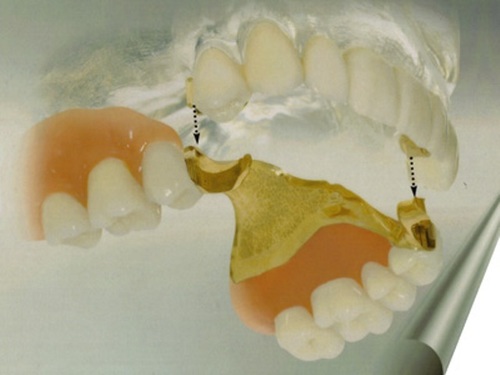
Acrylic prosthesis with locking system
The cost of an acrylic prosthesis for a patient is more dependent on the material used for its manufacture than on the length of the dentition defect. Depending on the wishes of the patient, acrylic can be used for the base and artificial teeth of Japanese firms (YamahachiHico),Czech companySpofadent, Russian firms. The price of a partial denture is formed on the basis of the method of its fixation to the supporting teeth. In addition to the above factors, the cost of the denture is significantly influenced by the qualifications of the dentist and the reputation of the clinic where he works, the table shows the average prices for this type of prosthetics.
|
№ |
Type of prosthesis |
Type of fixation |
Cost (in rubles) |
|
1. |
Full acrylic denture |
The prosthesis is held by creating a rarefied space between it and the surface of the mucous membrane. |
From 7 to 15 000 |
|
2. |
Partial Acrylic Denture |
Klammernoe - with the help of metal hooks (clasps) |
5 to 12,000 |
|
Beam - with the help of a metal beam, fixed on the crowns of the abutment teeth, such fastening is more often used for periodontal diseases |
15 to 24,000 |
||
|
The castle (on the attachments) - like the fastening of the clasp dentures, consists of two parts, one of which is fixed on the crown of the abutment tooth and the other on the denture |
From 18 to 28 000 |
||
|
3. |
Temporary acrylic prosthesis, as well as prostheses; prosthesis used in pediatric practice; replacing untimely removed milk teeth |
Most often partial with clasp mount |
From 5 to 10 000, its cost may be included in the price of permanent prosthetics |
Stages of manufacturing acrylic orthopedic structures
Thanks to simple technology, the manufacture of acrylic prostheses takes a short time (on average from 3 to 7 days, with complex works, the production time can stretch up to 10-14 days). The time taken by the laboratory stages of the manufacture of acrylic prostheses depends on the location and technical equipment of the laboratory. Clinics that have their laboratories located in the same building with dental offices can offer the manufacture of an acrylic prosthesis literally within 1 day.
Before installing prostheses, a preparatory stage is needed, during which the dentist will eliminate all problems in the patient’s oral cavity as much as possible (cure caries and its complications, conduct the necessary therapy for inflammatory diseases - gingivitis, periodontitis; remove teeth that cannot be treated).
Stages of prosthetics with acrylic prostheses
- Clinical - preparation of abutment teeth and removal of impressions from the patient's jaws. Many dentists recommend covering the abutment teeth with stamped or cast crowns in order to prevent the development of caries in places where clasps touch them. In order to make acrylic prostheses, you will need two prints from both jaws. The duration of the first stage is from half an hour to two hours and it takes one visit to the dentist.
- Laboratory - in the dental laboratory, on the basis of the impressions provided, gypsum models are poured, with which bite wax rollers are made, this process lasts from 1 to 3 days.
- Clinical - it is necessary to bite the bite rollers to determine the characteristics of the bite and the height of the remaining teeth. The stage takes from 15 minutes to half an hour.
- Laboratory - modeling of the wax base with the production of artificial teeth on it, duration from 1 to 3 days.
- Clinical - fitting wax construction, takes from a quarter to half an hour.
- Laboratory - making acrylic prosthesis, grinding and polishing, from 1 to 3 days.
- Clinical - fitting and correction of the finished prosthesis.
If the technical laboratory is located in the same building with the dental office, several stages can be combined into one, especially when a temporary acrylic prosthesis is required to replace the dentition defect in anticipation of a permanent non-removable prosthesis.
Care of the prosthesis and rules of its operation
In order to extend the service life of the acrylic construction to the maximum, you must carefully care for the prosthesis and follow the rules for its use:
- after each meal, remove and rinse it under cool water;
- brush twice a day with a regular toothpaste without bleaching and abrasive components or using a specially designed product;
- once a day, you can put the prosthesis in a disinfectant solution, it can be purchased at the pharmacy (or you can prepare it yourself from the products intended for cleaning prostheses bought at the pharmacy);
- you should visit the dentist at least once a year to monitor the condition of the prosthesis and tissues of the oral cavity;
- Do not eat too hard or sticky foods (crackers, toffee, caramel, meat bones);
- it is necessary to abandon the use of chewing gum;
- Since the acrylic base has increased brittleness, it is necessary to try to protect the prosthesis from falls or increased load directed at one point, which can lead to its failure.
Repair of acrylic dentures
When using a prosthesis, there may be cases leading to the repair of the structure, such cases include:
- tooth extraction - in this case, it is possible to increase the artificial basis (all sets are standard, so the difference between the old and the new will not be noticeable), even a remote abutment tooth can be replaced;
- loss of an artificial tooth from the prosthesis or its chipping - the tooth is replaced;
- break off clasps or the need to add another locking element;
- incomplete fit of the basis of the prosthesis to the tissues of the prosthetic bed - it is possible to relocate the prosthesis;
- the formation of chipping or cracks on the basis - after repair in this case often requires adjustment
- base failure - in this case, repair of the prosthesis or its replacement is possible depending on the period of use and the complexity of the failure.
It takes less than a day to repair an acrylic prosthesis, it will not be necessary to pay for it, if the warranty period has not yet passed (usually it is a year from the date the prosthesis was handed over);
Patient Reviews on Acrylic Dentures
Marina Ivanovna, 58 years old: I put the partial acrylic denture on the upper jaw just a few months ago, I was attracted by the low cost, while I was absolutely satisfied. Fasteners are not visible, keeps securely and does not cause discomfort when chewing. I just got used to it for quite a long time, I felt a hard foreign body in my mouth.
Igor Anatolyevich, 62 years: When installing acrylic prostheses, it was found that I have a very pronounced gag reflex, but the dentist said that after adaptation I could wear my prostheses, in the end I had to completely redo everything, because I could not get used to them. Now I wear byugel, they have a much smaller area of the base.
Svetlana, 48 years old: It has long removed the lower molars on both sides, could only chew on the front ones, like a rabbit. Since there was no financial opportunity to choose a different type of prosthetics, I stopped at a partial acrylic denture for the lower jaw. I have been wearing it for three years now, I don’t need to be replaced yet, in the first days it was very uncomfortable and then I got used to it and no longer notice it, but I can eat without problems.

